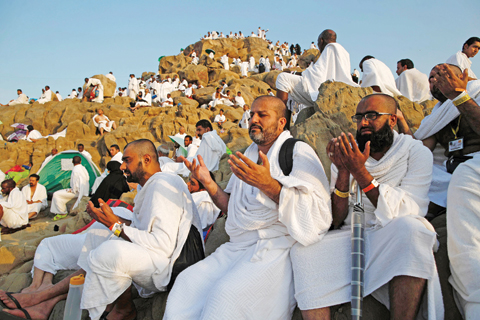 MOUNT ARAFAT: Pilgrims join the high point of the hajj rituals on Mount Arafat near Makkah yesterday. — AFP
MOUNT ARAFAT: Pilgrims join the high point of the hajj rituals on Mount Arafat near Makkah yesterday. — AFPMOUNT ARAFAT, Saudi Arabia: The hajj reached its high point yesterday when Muslims from across the world converged on a stony hill in Saudi Arabia, a year after the worst tragedy in the pilgrimage's history. More than 1.8 million gathered from sunrise at the hill and a vast surrounding plain known as Mount Arafat, about 15 km from Makkah. They are spending the most important day of the annual hajj in prayer and reading from the Holy Quran.
Arafat is the site where Prophet Muhammad (PBUH) gave his last sermon about 14 centuries ago after leading his followers on the pilgrimage. "I have the impression of standing exactly in front of God, said Khadem Ndyaye, 47, of Senegal. "Muslims came here from everywhere and we are all the same. If all the world was like that, there wouldn't be any war. Here, we feel that Islam is a religion of peace." Indian pilgrim Mohammed Arafan, 40, said he feels "chosen by God" for being able to perform the hajj. "It's beautiful to see the Muslims of the world pray together here."
"I have prayed to God to have mercy on us, give us relief and resolve Syria's crisis," said Um Fadi, wearing a traditional long black embroidered dress and head scarf native to her home in southern Syria. "From the bottom of my heart, I pray that God will lift this agony from Syria and its people," she added.
At midday prayer hundreds of thousands prostrated themselves, men and women side-by-side, in wide alleys that run between prefabricated pilgrim lodgings. For the first time in years, Saudi Arabia's Grand Mufti Abdul Aziz Al-Sheikh did not give his traditional Arafat sermon. Okaz newspaper cited health reasons but Sheikh still attended the sermon given in his place by Abdul Rahman Al-Sudais, imam of Makkah's Grand Mosque.
Under multicolored parasols to protect against the burning sun, the mass of people move through broad streets which are closed to traffic around Mount Arafat. Throughout the day the faithful chant a traditional hajj incantation, "God, here I am." From a distance, the hill appeared a snowy white from the seamless two-piece white garment, ihram, worn by male pilgrims. They come from every corner of the globe, but Indonesia - the most populous Muslim nation - has the largest contingent.
In stifling heat, trucks loaded with bottled water were stationed throughout, and pilgrims doused themselves. Empty bottles and leftover meals littered the ground as ambulances patrolled. After sunset they moved to Muzdalifah, halfway between Arafat and Mina, to gather 49 pebbles for a symbolic stoning of the devil which begins today, in the last major rite of hajj.
During that ritual in Mina last year a stampede killed roughly 2,300 people who were on their way to throw their stones at the Jamarat Bridge. Saudi Arabia issued a death toll of 769 but figures compiled from foreign officials in more than 30 countries gave a tally almost three times higher. Authorities announced an investigation into the tragedy but no results have ever been released, although a number of safety measures have been taken.
Among these is the distribution of a bracelet which stores pilgrims' personal data. Roads have also been widened in the Jamarat area, newspapers reported. Pilgrims have told AFP they feel safe and noticed organizational improvements. Yesterday, helicopters monitored the crowd flow from the skies, while on the ground, police on foot, motorbike, and all-terrain vehicles directed pedestrian movement. At the sacred hill itself, police sometimes had to use their bodies to block the flow of pilgrims and avoid bottlenecks. Crown Prince Mohammed bin Nayef, the interior minister and chairman of the hajj committee, was in Mina to help supervise "the services being provided to the pilgrims," the official Saudi Press Agency said.
Saudi Arabia yesterday said it launched a television channel to broadcast the hajj rituals in the Persian language, also known as Farsi, spoken in Iran. Minister of Information and Culture Adel Al-Turaifi said the 24-hour satellite channel would cover hajj rituals and prayers from the Grand Mosque in Makkah. "The channel aims to broadcast the message of the hajj, the eternal meanings of Islam and to show what is being provided by the kingdom" during the pilgrimage, the Saudi Press Agency quoted Turaifi as saying. It targets "Persian-language speakers, whose number is estimated at 130 million all over the world," he said. Farsi is primarily spoken in Iran, Afghanistan and Tajikistan.
For the first time in nearly three decades, 64,000 pilgrims from Iran are not participating in the hajj, after the regional rivals failed to agree on security and logistics. The Persian-language channel also has radio and internet services, Turaifi said. With 60 staff, the channel began broadcasts on Saturday evening and will continue until Wednesday, officially the last day of the hajj, which has drawn more than 1.8 million faithful. Iran operates its own Arabic-language news channel, Al-Alam, which is available by satellite and through a terrestrial transmitter in parts of neighboring Iraq. - Agencies









